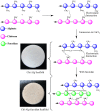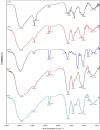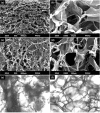Chitosan-alginate biocomposite containing fucoidan for bone tissue engineering
- PMID: 24441614
- PMCID: PMC3917275
- DOI: 10.3390/md12010300
Chitosan-alginate biocomposite containing fucoidan for bone tissue engineering
Abstract
Over the last few years, significant research has been conducted in the construction of artificial bone scaffolds. In the present study, different types of polymer scaffolds, such as chitosan-alginate (Chi-Alg) and chitosan-alginate with fucoidan (Chi-Alg-fucoidan), were developed by a freeze-drying method, and each was characterized as a bone graft substitute. The porosity, water uptake and retention ability of the prepared scaffolds showed similar efficacy. The pore size of the Chi-Alg and Chi-Alg-fucoidan scaffolds were measured from scanning electron microscopy and found to be 62-490 and 56-437 µm, respectively. In vitro studies using the MG-63 cell line revealed profound cytocompatibility, increased cell proliferation and enhanced alkaline phosphatase secretion in the Chi-Alg-fucoidan scaffold compared to the Chi-Alg scaffold. Further, protein adsorption and mineralization were about two times greater in the Chi-Alg-fucoidan scaffold than the Chi-Alg scaffold. Hence, we suggest that Chi-Alg-fucoidan will be a promising biomaterial for bone tissue regeneration.
Figures







References
-
- American Academy of Orthopaedic Surgeons Home Page. [(accessed on 21 December 2013)]. Available online: http://www.aaos.org/news/aaosnow/jan08/reimbursement2.asp.
-
- Jayakumar R., Menon D., Manzoor K., Nair S., Tamura H. Biomedical applications of chitin and chitosan based nanomaterials—A short review. Carbohydr. Polym. 2010;82:227–232. doi: 10.1016/j.carbpol.2010.04.074. - DOI
-
- Muzzarelli R.A. Chitins and chitosans for the repair of wounded skin, nerve, cartilage and bone. Carbohydr. Polym. 2009;76:167–182. doi: 10.1016/j.carbpol.2008.11.002. - DOI
Publication types
MeSH terms
Substances
LinkOut - more resources
Full Text Sources
Other Literature Sources

